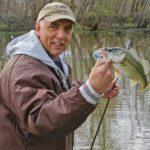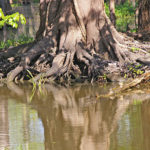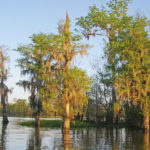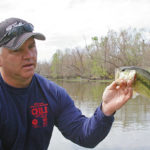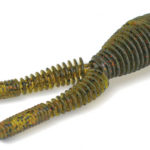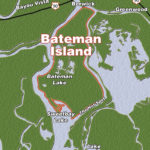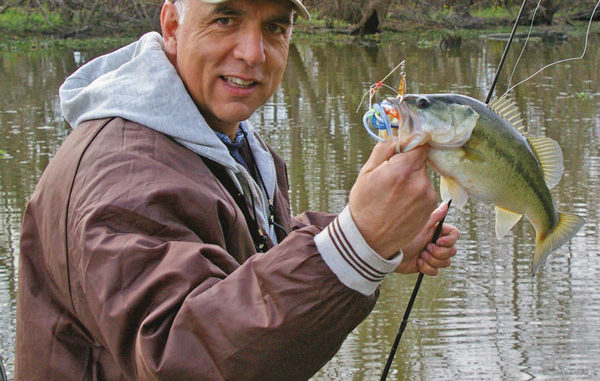
There’s never a shortage of boats fishing for bass this time of year at Bateman Island, but the fish don’t mind the pressure one bit.
Getting to a favorite fishing location shouldn’t require setting up a tent at the local boat landing to be there before everyone else. Fishing bass is supposed to be a leisure sport, with maybe a little banter between partners enjoying the day — as long as you don’t have a 3 p.m. weigh in.
No, it’s much preferred to wake up on a Saturday morning just before sunrise, then stop by the closest drive-thru for a biscuit and coffee, and be on the water fishing as the first rays of sun peak above the eastern horizon.
The problem with favorite locations is usually everyone else has the same thing in mind when word gets out the fish are biting. Such is the case with Bateman Island, particularly in March before the river rises.
Only minutes from the Berwick Landing, Bateman Island was the destination Bayou Vista resident Ray Beadle and good friend Jerry Gauthier would be fishing. Centerville friend Eddie Darce and I said we would rendezvous with them at some point during the morning just to check up and see who caught what.
Upon arrival, we passed up our friends, who had already put a couple of fish in their boat, and decided to head toward the back half of the canal to find some clearer water.
To our dismay, not one, not two, not three, four, five or six, but seven boats were already fishing the remaining long stretch, where we planned to start. Like a merry-go-round, bass boats spaced a hundred yards or more apart circled what locals refer to as the bass canal — and we were last amongst them, way too late for first dibs but not too late to pile on.
The thing about this particular morning in March was that though boats passed a spot with guys chunking lures, getting strikes and catching fish, another boat would troll by the same location and repeat what the boat ahead of them had just done.
Beadle fishes Bateman religiously throughout the year, not just for bass but for sac-a-lait also.
“There are three gigantic marshes that flow into that area, feeding it for many years,” he said. “The river feeds the estuary, completely restocking it year after year. We’ll catch a 20-bass limit in our boat and another boat will catch 20-bass right behind us. If there are 5,000 bass taken out of there in a season, there are another 5,000 taken the next year we didn’t get. I don’t know the numbers; I’m just saying there is a phenomenal number of bass in there.”
What bass anglers will find on Bateman is what they typically find in the marshes down the Atchafalaya River below the Intracoastal — lots of structure in the form of logs, cypress and tupelo tree stumps, roots and other semi-submerged manmade oilfield apparatus.
What they’ll also find is shallow-water washouts, drainages, grass mats and dead-end canals. Productive techniques include bouncing jigs, plastics and spinnerbaits off the bases of trees like bait falling into the water, running them parallel along logs and drifting them on the downstream sides of points, grass mats and vegetation, where the water is moving.
The location does have its caveats in that most anglers prefer clear water. Bateman Island is susceptible to river fluctuation, rain and higher-than-normal tides that muddy the water. Therefore, fishermen who frequent the region — and there are a lot of anglers who do — pay close attention to weather patterns and river stages. But catch the water right in early March, and Bateman is a go-to place not far from the boat launch.
Patterson resident and tournament bass angler Gary Blanco frequents “the Island,” as he refers to it, particularly when he is in need of a kicker fish that might push him over the top at the weigh-in.
“There have been times, when fishing a tournament, I’ve had my limit and needed a bigger fish,” he said. “I’ve pulled up in the Bass Canal and wouldn’t have to go far, and I’d catch my kicker — usually a 3-plus-pound fish. That has happened to me pretty often. You can go just about anywhere on that island and, at certain times, get that kicker-fish.”
Like a lot of areas along the Atchafalaya River impacted by hurricanes and seasonally high water, things change. Blanco has fished the area long enough to see the good and the bad. In 2009, things seemed to be better for bass anglers.
“Each year, things change, and some of the canals have started to silt in,” he said. “And for a while, the Bateman area slacked up because of all the storms we’ve had. That’s some of the changes I’ve seen over the years.
“At one time, it wasn’t anything to go out and catch 18 to 20 pounds of fish in late winter or early spring. But in the spring of ’09, it was really good, and the fish really got hammered. It was the best I’ve seen it in quite awhile, and I think it’s going to be another good year again this year.”
Though locals fish the area year-round, Blanco, a self-proclaimed spinnerbait man, prefers the water when it is slightly above flood stage.
“Personally, I like fishing the area when the water is high,” he said. “When the river is anywhere from 4 1/2 to 5 feet, that’s when I really like to fish there. Anything above that, you’re wasting your time. That range is already a foot above flood stage, and when you get to 5-1 and 5-2, you get a lot of overflow from the river.”
Like most anglers fishing for bass and other game fish off of the river and in the Atchafalaya Basin system, Blanco prefers and looks for moving water — not necessarily a falling tide, either.
“I look for water movement and, believe it or not, have had good success with an upcoming tide,” he said. “I’ve caught my bigger fish with a slow rise during the spring at certain times. But in late winter and early spring, you can catch fish on an up tide.
“I throw a 1/2-ounce slow-rolling spinner-bait with a gold blade most of the time, and I pay attention to where I’m getting my bites — in or out. You toss a bait against that tree stump and let it drop parallel, and they’ll hit it. But it’s often finding what they want — that’s the main thing.”
Recreational fishermen and tournament bass anglers coming into the region shouldn’t be afraid of the number of boats they see. The area receives pressure year-round, but doesn’t seem to stop producing winning stringers.
“I’ve gone behind a bunch of boats in there, and I don’t know what they are throwing or what they’re catching, but I catch fish,” Blanco said. “When the bass canal is under pressure, I’ll sometimes throw a wacky worm or something a little different.”
The limit for the area is 10 bass per person with no size constraint. Though the area sees quite a few tournament anglers who catch and release, many fish find their way into the frying pan as well. That shouldn’t dissuade tournament anglers from looking for their five fish at Bateman Island; there are plenty of bass that will go 3 pounds or better.
Getting in line, Darce and I can’t say we slammed them on that March morning in 2009, but we didn’t go home empty-handed. We were pleased with the strikes and fish we did land after being so late — not to mention behind so many.
Of course, the phone call I got from Beadle, wondering where we went after they passed us up on the island, told me we left too many in the water on our trip to Bateman Island.
This spring, I’ll skip the coffee and biscuits, and won’t be late to pile on with the rest of the
locals.
